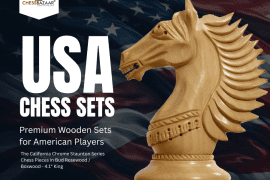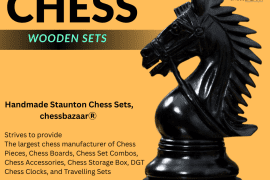Adding a New Dimension to an Ancient Game
Picture Commander Spock and Captain Kirk locked in a battle across layers of chess squares—this iconic scene from Star Trek transformed #D Chess into a symbol of advanced strategic thinking. Playing chess across multiple boards became shorthand for thinking multiple steps ahead in both fiction and everyday metaphor.
But 3D chess is more than just a cultural reference. It’s a real-world evolution of traditional chess—adding vertical space and making gameplay richer, more challenging, and visually dramatic.
This guide is your all‑in‑one resource for understanding, playing, and collecting 3D chess sets. We’ll explore its deep history, reveal how it’s played, compare 3D vs. 2D strategy, review the best sets you can buy today, and offer DIY tips for building your own.
What Is 3D Chess? Beyond an Eye Catching Prop
3D chess isn’t one game—it’s a category of chess variants that add verticality to the traditional board. Two main styles dominate:
• Tiered (Stacked) Boards
These sets stack multiple playing surfaces vertically, often suspended on pillars. Classic examples include the Strato Chess and Star Trek‑inspired sets. The result is a multi‑level battlefield offering entirely new move dimensions.
• Sculptural (Topographic) Boards
These boards keep the traditional 64 squares, but each square sits at a different height, forming hills and valleys. While they work with standard chess rules, they transform the board into a functional piece of art where controlling the “high ground” has literal meaning.
This category split highlights two different buyer motivations: playability vs. aesthetic appeal. Decorative sculptural boards are prized for artistry, while tiered sets are prized for their multi‑dimensional gameplay.
A Journey Through Time — The History of 3D Chess
1851 – Kubikschach (Cube Chess)
Invented by Lionel Kieseritzky, this bold 8×8×8 cube variant was ambitious but overwhelmingly complex—“the most mentally indigestible” among inventors, according to critics.
1907 – Raumschach (Space Chess)
Ferdinand Maack created the most elegant early version: a 5×5×5 board featuring the Unicorn piece, which moves along space diagonals. Raumschach remains the most logically coherent attempt at real 3D chess.
Star Trek: Cultural Explosion of Tri Dimensional Chess
The Star Trek prop appeared in the episode Where No Man Has Gone Before. Built from toy kits, its rules were never explained—and layout often varied. Still, its visual impact sparked massive interest in a playable version.
Post Trek Developments
Fans and designers responded. In the 1990s, Max Chappell created Hyperchess at conventions. In 2001, William L. D’Agostino launched Millennium 3D Chess, offering three full 8×8 boards and minimal rule changes—designed to feel familiar to traditional players.
Anatomy of a 3D Chess Board — Types & Styles
Sculptural (Topographic) Boards
Handmade with woods like walnut and maple, these unique boards function as both art and chess. They play standard chess but offer striking visuals—perfect for decor and conversation.
Tiered (Stacked) Boards
Classic sets such as Strato 3D offer three stacked levels—aluminum, acrylic, plastic materials—with real multi‑level gameplay experience. Some users report durability issues or poorly written instructions, especially in lower-end models.
Star Trek Tri Dimensional Chess
Featuring three fixed 4×4 platforms and four moveable 2×2 “attack boards,” this iconic design is available from The Noble Collection. It’s praised for screen accuracy and collectible quality but critiqued for gameplay ergonomics and ambiguous rules.
3D Printed Themed Sets
Online platforms like Etsy, Cults3D, and Thingiverse now offer themed chess sets—from sushi to Star Wars. Buyers can purchase finished sets or downloadable STL files to print. Materials range from PLA to resin; quality and price vary widely.
Smart Boards—The Digital Physical Hybrid
Boards like Square Off and Chessnut offer automation and online connectivity—letting you play physically against opponents in online play. It combines tactile gameplay with modern convenience.
How to Play — Rules of 3D Chess
General Vertical Movement Extensions
- Rooks, Bishops & Queens: Rooks move vertically through files; bishops follow diagonal paths across levels; queens combine both.
- Knights: Retain L‑shape movement, extended to include vertical shifts (e.g. two forward, one up).
- Pawns: Move forward on a board, may move vertically or diagonally upward/downward to capture.
- Kings: Move one square in any horizontal, vertical, or cross‑level direction.
Millennium 3D Chess
Uses three full 8×8 boards and introduces rules with minimal deviation—ideal for players moving from 2D chess. Rooks may move vertically; bishops cannot. Clear rulebooks make it accessible.
Star Trek Tri Dimensional Chess
High complexity and high drama. Attack boards are movable under specific conditions (e.g. empty or only your pawn). Two main rule sets exist:
- Andrew Bartmess’s “Standard Rules” (1976): historically popular but sometimes ambiguous.
- Jens Meder’s “Tournament Rules”: more rigorous and FIDE‑aligned—preferred for serious play.
Thinking in Three Dimensions — Strategy Compared
- Pattern recognition breaks down: Familiar 2D chess tactics look completely different in 3D—creating a steep learning curve.
- Control becomes volumetric: Center control is now a vertical column or volume. Files and levels matter.
- Piece value shifts: Extended-range pieces like queens, bishops, and rooks become even more powerful when they can traverse levels.
- New tactics emerge: Multi-level forks, pins, and skewers become possible. Knights can attack pieces across different boards simultaneously.
- Physical boards help: Visualizing onboard moves on a flat screen can be confusing—physical and smart boards help reinforce spatial clarity.
Best 3D Chess Sets to Buy Today — 2024/2025 Review
Here’s a buyer’s guide across different priorities:
Set & Type | Best For | Key Materials | Approx. Price | Pro | Con |
Noble Collection Star Trek Tri‑Dimensional Chess | Sci‑Fi fans & collectors | Die‑cast metal, acrylic | $145–150 | Accurate design, collectible quality | Rules ambiguous, gameplay ergonomics can be awkward |
Handmade Topographic Wooden Boards | Art & decor enthusiasts | Walnut, pine, maple | $150–400+ | Striking craftsmanship and uniqueness | Plays standard chess only; no multi‑level rules |
Strato 3D Multilevel Set | Newcomers to vertical gameplay | Aluminium, plastic, acrylic | $70–90 | Affordable introduction to 3D strategy | Build quality and rule clarity can vary |
3D‑Printed Themed Sets | Personalization & creativity | PLA, resin, filaments | $2 (STL)‑100+ | Endless themes, scalable customization | Quality varies; requires careful research |
DIY Grandmaster—How to Build Your Own 3D Chess Board
• Woodworking Approach (Topographic)
- Plan square heights across a grid of 64 blocks.
- Cut contrasting hardwoods (e.g., walnut & maple) to size.
- Assemble and glue rows into a height‑dimensional board.
- Sand, lacquer, and finish to create a smooth, durable, artistic surface.
• 3D Printing Method
- Locate a design online (Thingiverse, Cults3D, Etsy).
- Choose materials: PLA (easy & colorful) or Resin (detailed, transparent).
- Print and post‑process: sand, add weights or felt bases for stability and feel.
- Assemble set for play—or display—and customize paint, scale, or theme.
Beyond the Cube — Related Geometric Variants
- Cylindrical Chess: The board wraps from a‑file to h‑file, letting pieces cross the seam. Bishops gain powerful diagonals, and endgames change radically—castling is often modified or omitted.
- Spherical Chess: Played on a globe with curved geometry. Movement across poles or triangular boards complicates piece behavior. These sets often become sculptures, as much about art and engineering as gameplay.
FAQs — Quick Answers
How is 3D Chess different from regular chess?
It adds vertical layers to the battlefield, allowing pieces to move up/down between levels, fundamentally altering tactics and board control.
Is 3D Chess hard to learn?
Basic moves are logical extensions, so learning isn’t hard—but mastery is. You must develop spatial visualization across levels that doesn’t exist in 2D.
Where can I buy a 3D chess set?
Explore Etsy and Cults3D for artisanal or 3D‑printed options. The Noble Collection sells official Star Trek replicas. Strato sets are widely available at game retailers or online.
Also Check CHESS BAZAAR For Premium Chess Set, Chess Pieces, Chess Board
Can I play 3D Chess online?
Yes. Chess platforms like Chess.com offer 3D views of standard games. For Star Trek chess variants, dedicated apps exist. Smart boards like Square Off and Chessnut let you play physically while connected to digital opponents.
What are the official rules for Star Trek chess?
No single “official” rules exist. The best‑known are:
- Bartmess Standard Rules (1976) — historic but sometimes unclear.
- Meder Tournament Rules — more rigorous and aligned with FIDE chess standards.
Conclusion: Your Move
3D chess has evolved from intellectual curiosities like Raumschach to cultural icons thanks to Star Trek, and now thrives in a vibrant, customizable era of 3D‑printed design and smart hybrid boards.
Whether you’re captivated by its aesthetic beauty, intrigued by its gameplay, or ready to build your own, the world of 3D chess offers limitless ways to play—and think—in a new dimension.
The third dimension awaits. Your move.



